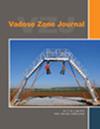Water‐ and air‐filled pore networks and transport parameters under drying and wetting processes
IF 2.5
3区 地球科学
Q3 ENVIRONMENTAL SCIENCES
引用次数: 0
Abstract
The connectivity and tortuosity of fluid‐filled pore networks in the water and air phases strongly influence the mass transport in porous media. Moisture conditions (water content and distribution) alter water‐ or air‐filled pore networks. In this study, using a sand column with variable saturated conditions, water‐ and air‐filled pore networks were analyzed using X‐ray computed tomography (CT). Water and air transport parameters, including hydraulic conductivity, gas diffusion coefficient, and air permeability, were measured. The objectives were (a) to identify the effects of entrapped air on the water‐filled pore network and hydraulic conductivity and (b) to understand the water‐ and air‐filled pore networks and relevant transport parameters in the sand column during the drying and wetting processes. Measurements of hydraulic conductivity using quasisaturated samples showed that hydraulic conductivity was drastically reduced when smaller in situ air bubbles were present inside the sand column. At the same air‐filled porosity, higher gas diffusivity and air permeability were obtained under wetting than those during drying. X‐ray CT image analysis revealed that the air‐filled pore network connectivity during wetting was higher than that during drying, resulting in enhanced gas transport parameters during the wetting process. The observed differences in water‐ and air‐filled pore networks during drying and wetting processes are highly promising for future multiphase mass transport models in soils.干燥和润湿过程中充满水和空气的孔隙网络和传输参数
水相和气相中充满流体的孔隙网络的连通性和弯曲性强烈影响多孔介质中的质量输运。湿度条件(含水量和分布)改变了充满水或空气的孔隙网络。在这项研究中,使用不同饱和条件的砂柱,使用X射线计算机断层扫描(CT)分析了充满水和空气的孔隙网络。测量了水和空气的输送参数,包括水力导率、气体扩散系数和空气渗透性。目标是(a)确定被困空气对充水孔隙网络和水力导电性的影响,(b)了解在干燥和润湿过程中砂柱中充满水和空气的孔隙网络以及相关的传输参数。使用准饱和样品进行的水力导电性测量表明,当砂柱内部存在较小的原位气泡时,水力导电性急剧降低。在相同的充气孔隙率下,湿法比干燥法获得更高的气体扩散率和透气性。X射线CT图像分析显示,润湿过程中充满空气的孔隙网络连通性高于干燥过程,导致润湿过程中气体输运参数增强。在干燥和湿润过程中观察到的充满水和空气的孔隙网络的差异对未来的土壤多相质量传输模型非常有希望。
本文章由计算机程序翻译,如有差异,请以英文原文为准。
求助全文
约1分钟内获得全文
求助全文
来源期刊

Vadose Zone Journal
环境科学-环境科学
CiteScore
5.60
自引率
7.10%
发文量
61
审稿时长
3.8 months
期刊介绍:
Vadose Zone Journal is a unique publication outlet for interdisciplinary research and assessment of the vadose zone, the portion of the Critical Zone that comprises the Earth’s critical living surface down to groundwater. It is a peer-reviewed, international journal publishing reviews, original research, and special sections across a wide range of disciplines. Vadose Zone Journal reports fundamental and applied research from disciplinary and multidisciplinary investigations, including assessment and policy analyses, of the mostly unsaturated zone between the soil surface and the groundwater table. The goal is to disseminate information to facilitate science-based decision-making and sustainable management of the vadose zone. Examples of topic areas suitable for VZJ are variably saturated fluid flow, heat and solute transport in granular and fractured media, flow processes in the capillary fringe at or near the water table, water table management, regional and global climate change impacts on the vadose zone, carbon sequestration, design and performance of waste disposal facilities, long-term stewardship of contaminated sites in the vadose zone, biogeochemical transformation processes, microbial processes in shallow and deep formations, bioremediation, and the fate and transport of radionuclides, inorganic and organic chemicals, colloids, viruses, and microorganisms. Articles in VZJ also address yet-to-be-resolved issues, such as how to quantify heterogeneity of subsurface processes and properties, and how to couple physical, chemical, and biological processes across a range of spatial scales from the molecular to the global.
 求助内容:
求助内容: 应助结果提醒方式:
应助结果提醒方式:


